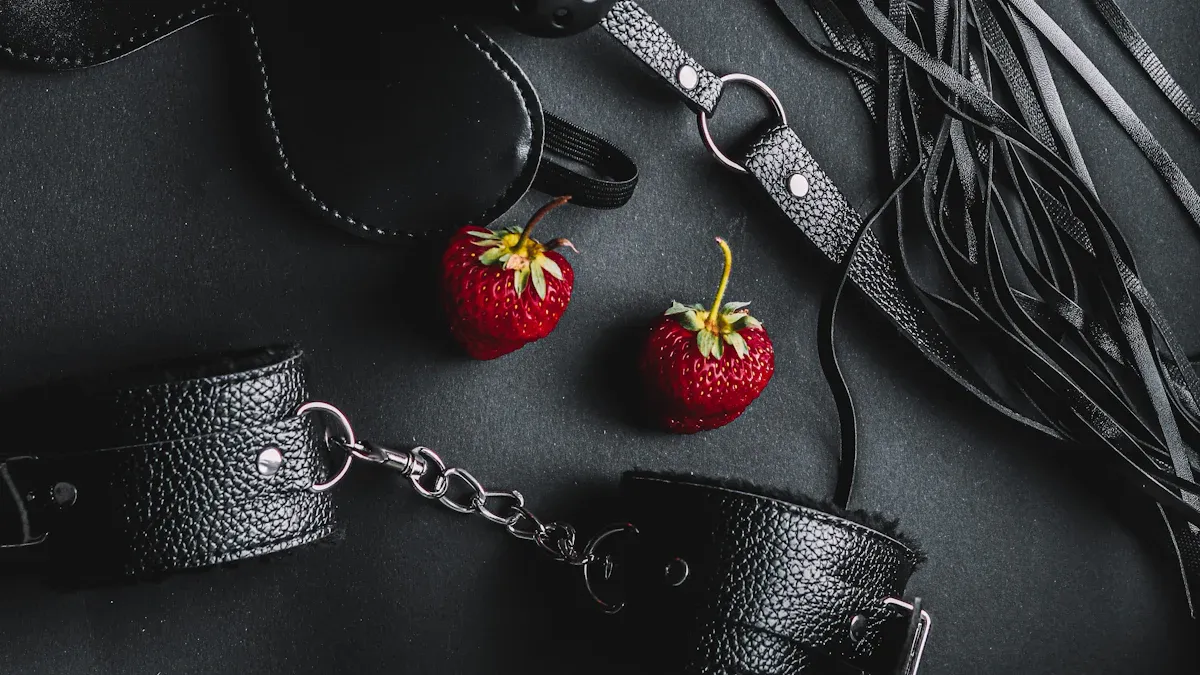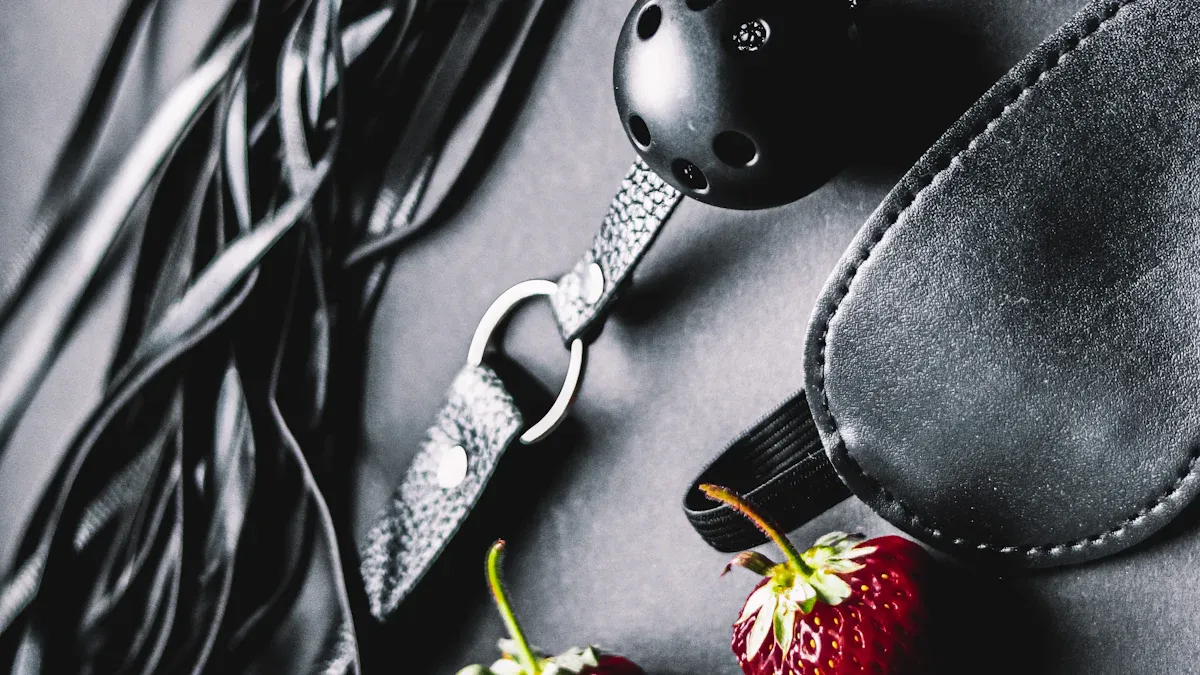
A standard bdsm kit often contains several essential items. Common accessories include restraints, blindfolds, gags, paddles, and floggers. Some kits also have collars or feather ticklers. Each item has a specific purpose and should be used with care. Beginners should learn how to use every item safely. Consent, communication, and safety matter most in any activity.
Key Takeaways
-
Consent and clear communication form the foundation of safe and enjoyable BDSM play.
-
Always prioritise safety by discussing boundaries, using proper restraints, and monitoring comfort during activities.
-
A standard BDSM kit includes items like restraints, blindfolds, gags, impact tools, collars, and sensory accessories, each with a unique purpose.
-
Beginners should start with simple, gentle items and learn how to use them safely before exploring more advanced tools.
-
Aftercare and open feedback help partners feel supported and build trust for positive experiences.
Safety and Consent

Consent Basics
Consent forms the foundation of all safe BDSM activities. Both partners must agree to every activity before play begins. This agreement should be clear and informed. The BDSM community often uses the phrase “safe, sane, and consensual” to highlight the difference between consensual play and abuse. Consent helps set boundaries and ensures that everyone feels respected. Studies show that participants in BDSM sessions discuss and agree on activities in advance. This process builds trust and makes the experience safer for everyone involved. Open conversations about consent also help reduce stigma and misunderstanding, making it easier for people to explore their interests responsibly.
Communication
Good communication keeps everyone safe and comfortable during BDSM play. Partners should talk about their limits, desires, and expectations before starting. Many people use safe words to signal when they want to pause or stop. Active listening and attention to body language help partners understand each other’s comfort levels. Research shows that regular check-ins and honest dialogue increase trust and satisfaction. In fact, studies reveal that people who practise BDSM often develop stronger communication skills and deeper trust with their partners. These habits make the experience more enjoyable and secure.
Safety Tips
Safety must always come first in any BDSM session. Beginners should follow these basic tips:
-
Discuss boundaries, limits, and safe words before play.
-
Use restraints designed for bondage, not makeshift items.
-
Check circulation and breathing often when using restraints.
-
Stop or pause activities if anyone feels uncomfortable.
-
Provide aftercare, such as cuddling or reassurance, to support emotional well-being.
Aftercare is important. It helps partners recover emotionally and physically after intense scenes. Research links aftercare to higher relationship satisfaction and better mental health. Practising safety, consent, and communication reduces risks and helps everyone enjoy BDSM play with confidence.
BDSM Kit Essentials
A standard bdsm kit contains several items designed to enhance trust, excitement, and exploration. Each item serves a unique purpose and requires understanding for safe and enjoyable use. Some kits also include instructional materials to help beginners learn proper techniques and safety tips.
Restraints
Restraints are a core part of many bdsm kits. They limit movement and create a sense of control or surrender. Common types include handcuffs, ropes, bondage tape, and soft cuffs. Beginners often choose padded cuffs or bondage tape because these reduce the risk of injury.
-
A literature review on fatal outcomes in BDSM play highlights the risks associated with restraints.
-
The review shows that proper knowledge and safety protocols are essential, especially for beginners.
-
A large survey of nearly 5,000 college students found that 58% of women had experienced choking during sex, with many starting before age 17.
-
Choking, a form of restraint, has become more common among young adults.
-
The practice carries health risks and shows the need for explicit consent and safety awareness.
-
Unwanted choking can happen even in consensual encounters, so clear communication is vital.
Tip: Always check for numbness, tingling, or changes in skin colour when using restraints. Remove restraints immediately if any of these signs appear.
Blindfolds
Blindfolds block sight and heighten other senses. They add mystery and anticipation to play. Most bdsm kits include a soft blindfold made from satin or leather. Blindfolds help build trust between partners. They also allow beginners to focus on touch and sound. Using a blindfold can make even simple sensations feel new and exciting.
Gags
Gags restrict speech and add a sense of vulnerability. Ball gags, bit gags, and breathable gags are common in bdsm kits. Beginners should start with breathable gags to ensure safety. Gags require extra care because they affect breathing and communication. Partners should agree on non-verbal signals before using a gag. This keeps everyone safe and comfortable.
Impact Tools
Impact tools deliver controlled sensations to the body. Paddles, floggers, and whips are the most popular options.
Experts such as Dr. Patti Britton and Francesca Gentille explain that impact play always requires consent, negotiation, and safe words. The BDSM community values communication and risk awareness. Education and training help prevent injuries.
A recent study shows the popularity of impact tools:
|
Impact Tool Category |
Interest Percentage |
Usage Percentage |
|---|---|---|
|
Impact toys (paddles, floggers, crops) |
62.41% |
37.59% |
|
Medical kink toys (pumps, gloves) |
24.11% |
6.38% |
|
Chastity toys (belts, packages) |
11.35% |
2.80% |
Paddles offer a broad, flat surface for gentle or firm strikes. Floggers have multiple tails and create a thuddy or stingy sensation. Whips provide sharp, intense sensations and require skill to use safely. Beginners should start with paddles or soft floggers.
Collars
Collars symbolise trust, ownership, or submission. Many bdsm kits include a simple collar with a buckle or Velcro closure. Some collars come with a leash for added control. Wearing a collar can feel meaningful and exciting. Partners should discuss the meaning and rules before using a collar.
Sensory Accessories
Sensory accessories add variety and excitement to play. Feather ticklers, pinwheels, and nipple clamps are common in many bdsm kits. Feather ticklers provide soft, delicate touches that create tingling sensations. They stimulate erogenous zones and keep sensory engagement high.
Experts recommend experimenting with different feather textures and lengths for a tailored experience. Feather ticklers are safe and easy for beginners to use. Nipple clamps add pressure and can heighten arousal. Pinwheels roll over the skin and create a prickly feeling.
Note: Some bdsm kits include guides or booklets. These materials help beginners learn about each item and how to use them safely.
Using Your BDSM Kit
First Steps
Many beginners feel excited and nervous when opening a new bdsm kit. They should start with the simplest items, such as soft restraints or a blindfold. Reading any included instructions helps users understand each tool. Partners can talk about what they want to try first. They might agree to use only one or two items during the first session. This approach builds trust and confidence.
Tip: Always keep safety scissors nearby when using restraints. Quick release tools prevent accidents and help everyone feel secure.
Safe Play
Safety remains the most important part of any BDSM activity. Studies show that fatal outcomes in BDSM play are very rare. One study found only 0.018% of 16,437 autopsies involved BDSM activities. Most incidents involved alcohol or drugs, so experts advise avoiding substances during play. Education and community support also play a big role in safe experiences. About 85% of practitioners in the USA learn from mentors, and 79% join groups that offer workshops on safety and aftercare. Partners should always agree on a safeword or use a "traffic light" system to stop or slow down play if needed.
-
Never leave a restrained person alone.
-
Check for signs of discomfort, such as numbness or changes in skin colour.
-
Keep emergency tools within reach.
Exploring New Items
After gaining confidence with basic tools, partners can try new items from the bdsm kit. They should introduce one new accessory at a time. Before using something new, they can discuss boundaries and set clear rules. Partners might use a table to track which items they have tried and how each person felt:
|
Item Tried |
Comfort Level |
Notes |
|---|---|---|
|
Blindfold |
High |
Felt safe and fun |
|
Soft cuffs |
Medium |
Needed more padding |
|
Feather tickler |
High |
Enjoyed sensations |
Open communication helps everyone feel respected. Partners can share feedback after each session and adjust their play as needed.
Choosing the Right Kit
Selecting the right bdsm kit depends on experience and personal interests. Beginners and experienced users have different needs. Understanding these differences helps people make safe and enjoyable choices.
Starter Kits
Starter kits suit those who are new to BDSM. These kits usually include basic items such as soft restraints, blindfolds, and a simple paddle or feather tickler. Manufacturers design these tools for comfort and safety. Soft cuffs and bondage tape reduce the risk of injury. Blindfolds in starter kits often use gentle materials like satin. A basic gag, if included, will allow easy breathing.
Tip: Beginners should look for kits with clear instructions or guides. These resources help users learn safe techniques and understand each item's purpose.
A starter kit should not feel overwhelming. It should offer a few well-chosen items that encourage exploration. Many people find that starting simple builds confidence and trust.
Advanced Options
Advanced kits appeal to those with more experience or specific interests. These kits may include a wider range of restraints, impact tools, and sensory accessories. Some advanced kits feature items such as leather collars, metal handcuffs, or more intense gags. They might also include nipple clamps, pinwheels, or larger floggers.
Quality matters more in advanced kits. Buyers should check for strong stitching, safe materials, and secure fastenings. A table can help compare features:
|
Feature |
Starter Kit |
Advanced Kit |
|---|---|---|
|
Item Variety |
Few |
Many |
|
Material |
Soft |
Durable |
|
Instructions |
Included |
Sometimes |
People should always match their kit to their comfort level and interests. Safety remains important at every stage.
A standard kit offers tools for safe and enjoyable exploration. Each item has a unique purpose. Understanding how to use these tools helps prevent harm. Open communication and clear boundaries support positive experiences. Research shows that reflecting on needs and setting expectations leads to safer and more adaptive play. Starting with simple items builds trust and confidence. People should continue learning at their own pace, always respecting consent and care.
FAQ
What is the safest item to try first in a BDSM kit?
Most beginners start with soft restraints or a blindfold. These items feel less intimidating and allow partners to build trust. Soft cuffs or satin blindfolds reduce the risk of injury and help users learn about consent and comfort.
How should someone clean BDSM kit items?
People should follow the manufacturer’s instructions. Most soft items need gentle soap and water. Metal or silicone tools require disinfectant wipes. Clean items after every use. Proper cleaning prevents infections and keeps the kit safe.
Can someone use a BDSM kit alone?
Yes, many people use certain items alone, such as blindfolds or feather ticklers. However, restraints and gags can pose risks if used without a partner. Safety always comes first. Avoid solo play with items that could cause harm.
Do all BDSM kits include instructions?
Not every kit includes instructions. Some starter kits provide guides or booklets for beginners. Reading instructions helps users understand each item’s purpose and safe use. If a kit lacks instructions, people can find reliable resources online.
What should someone do if they feel uncomfortable during play?
Anyone can stop play at any time. Use a safeword or signal. Partners should check in and offer support. Aftercare helps everyone feel safe and respected. Communication remains the key to a positive experience.










